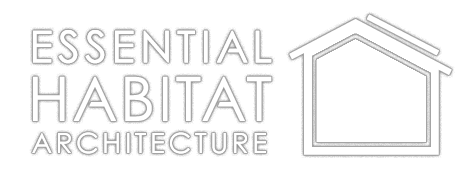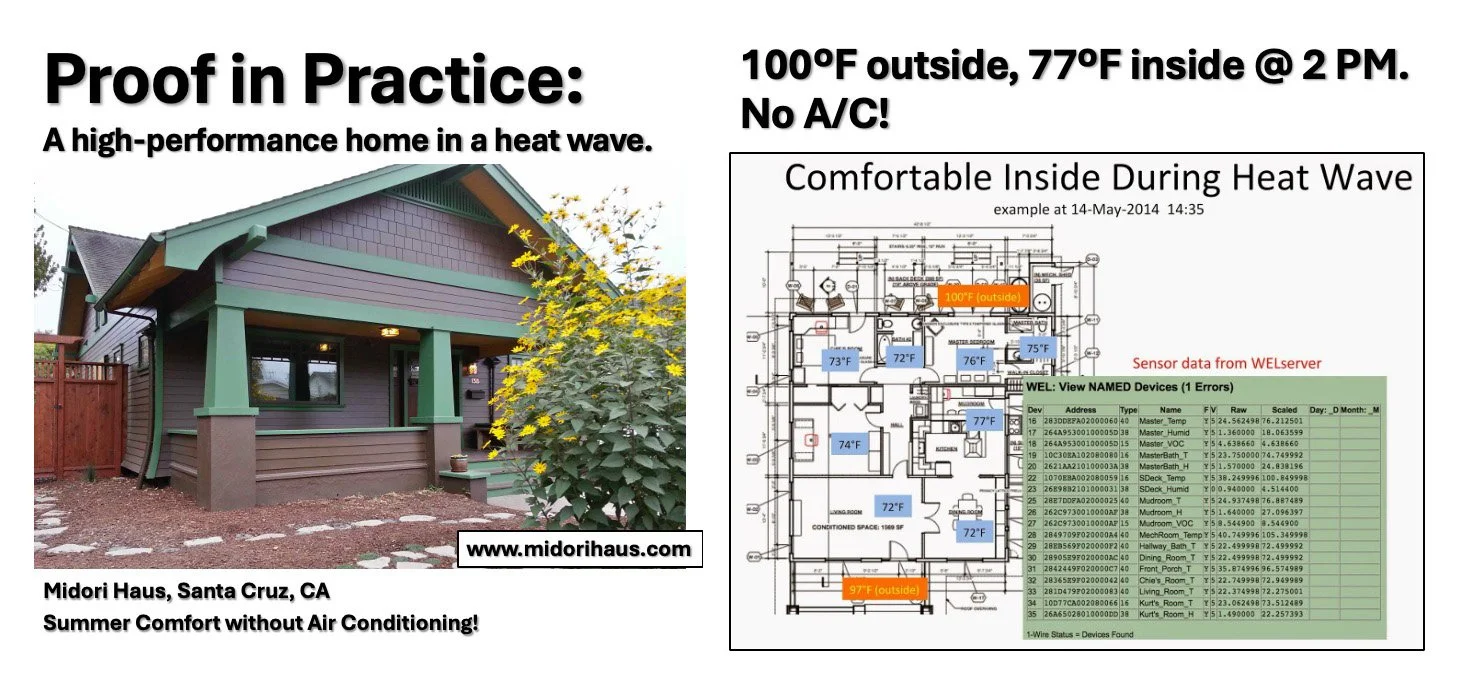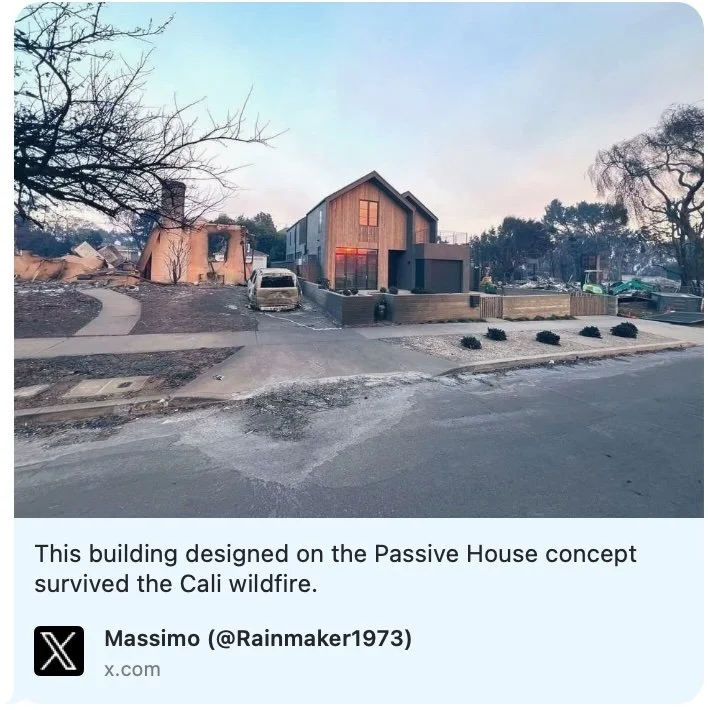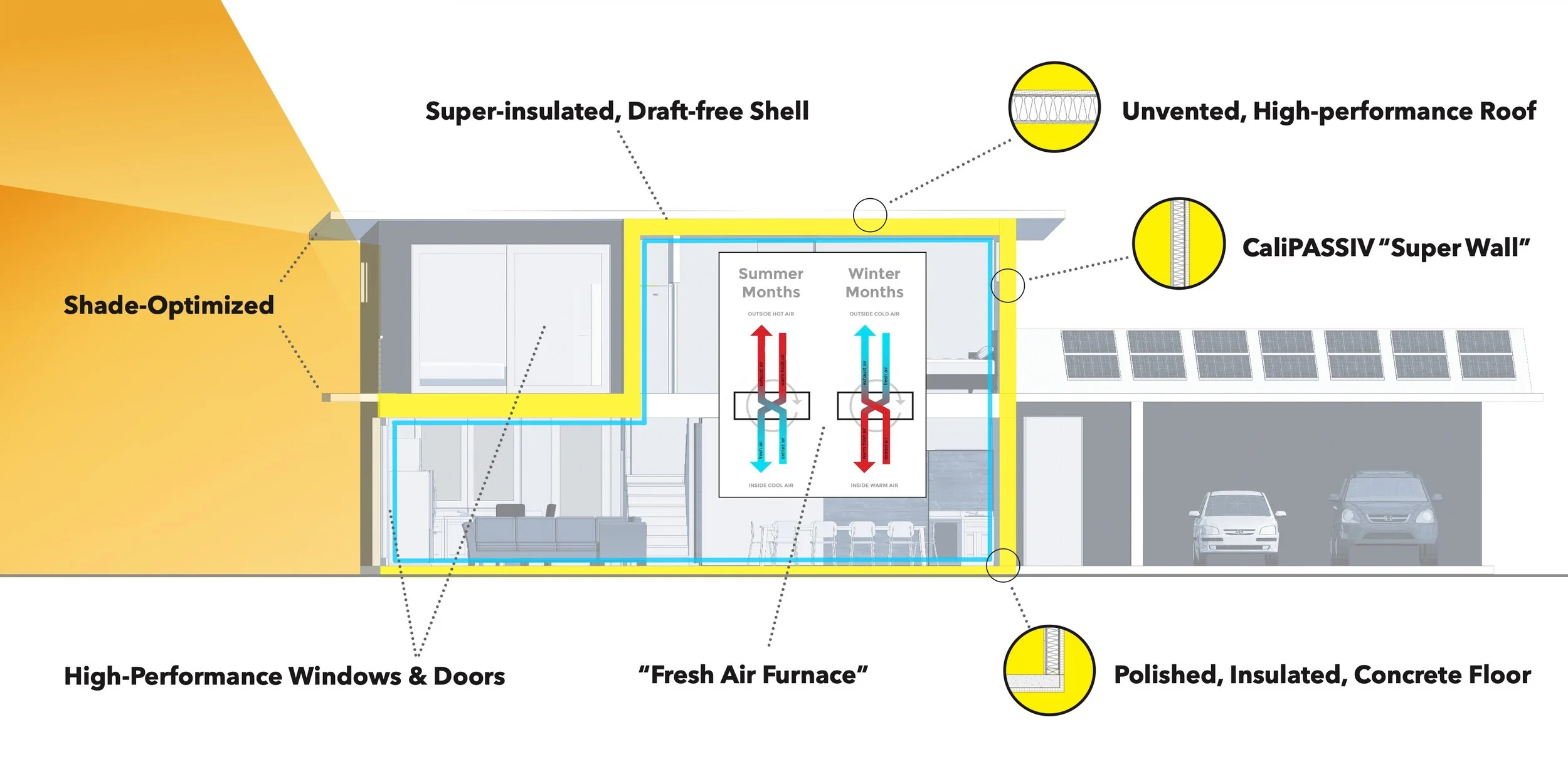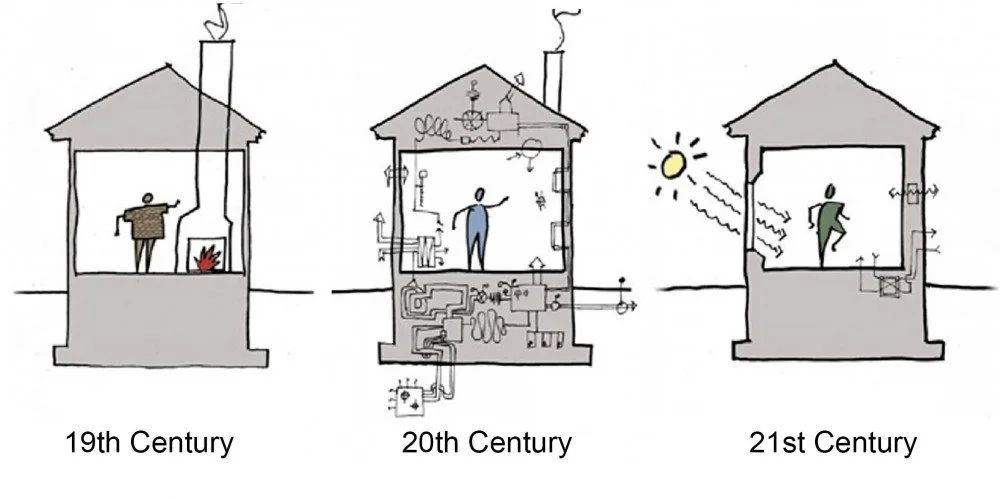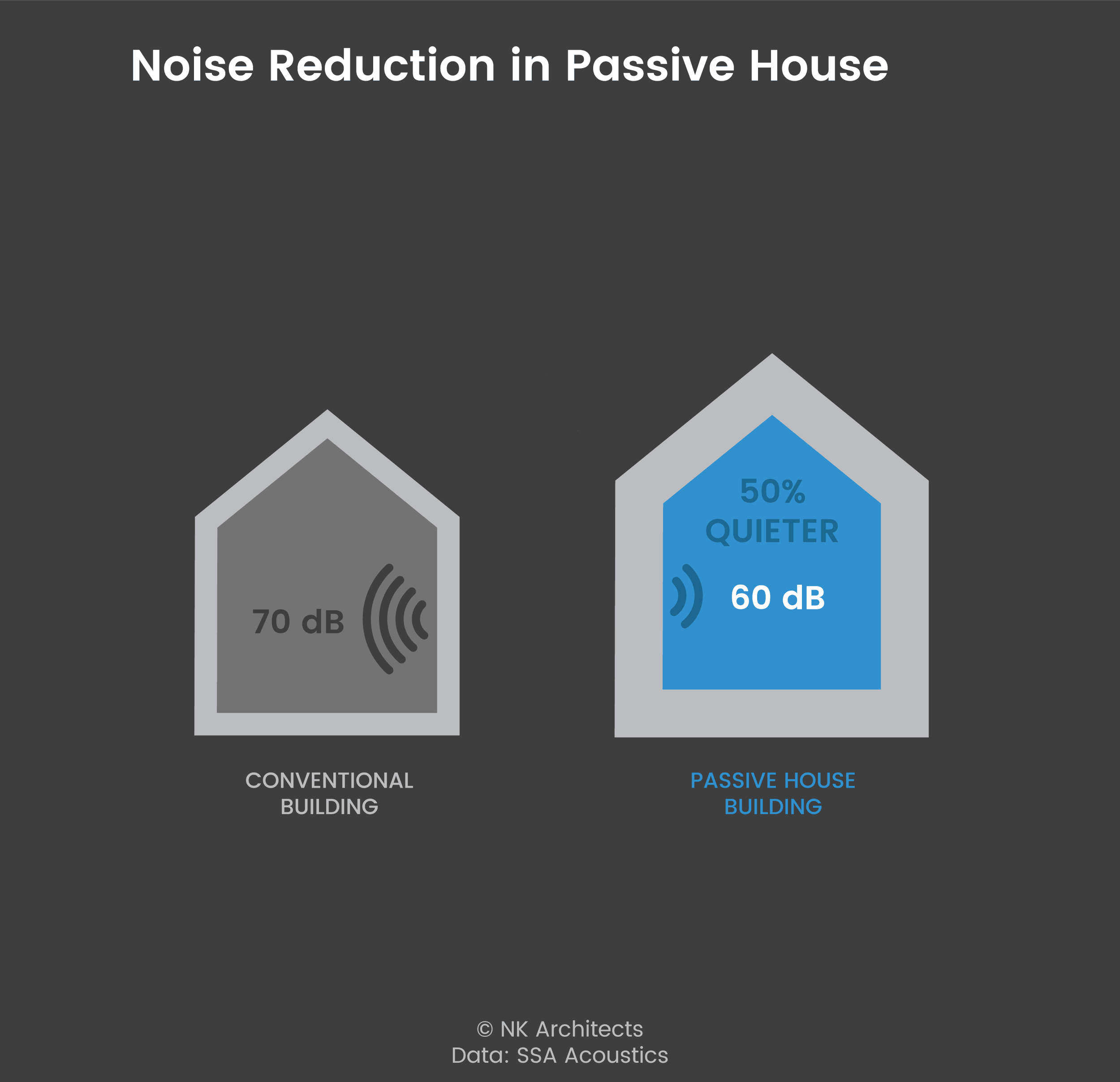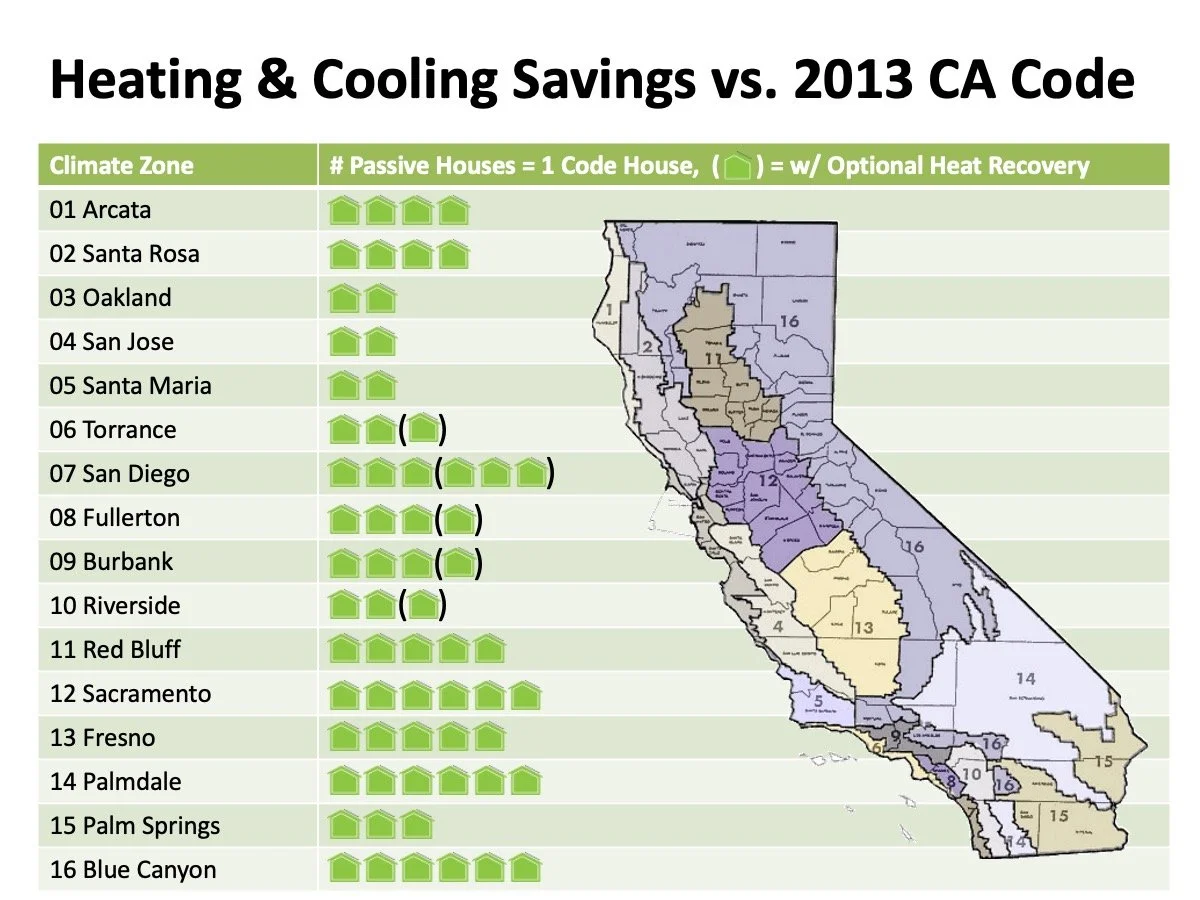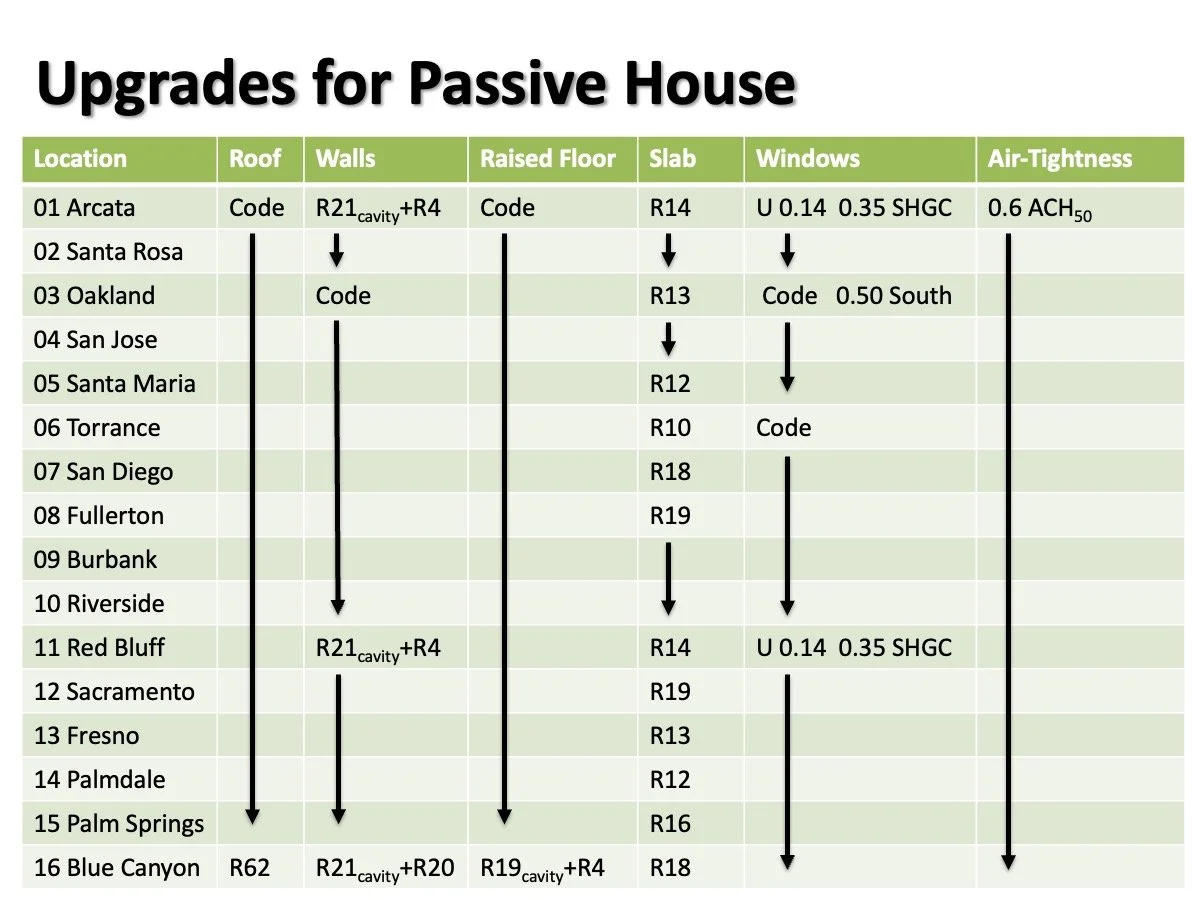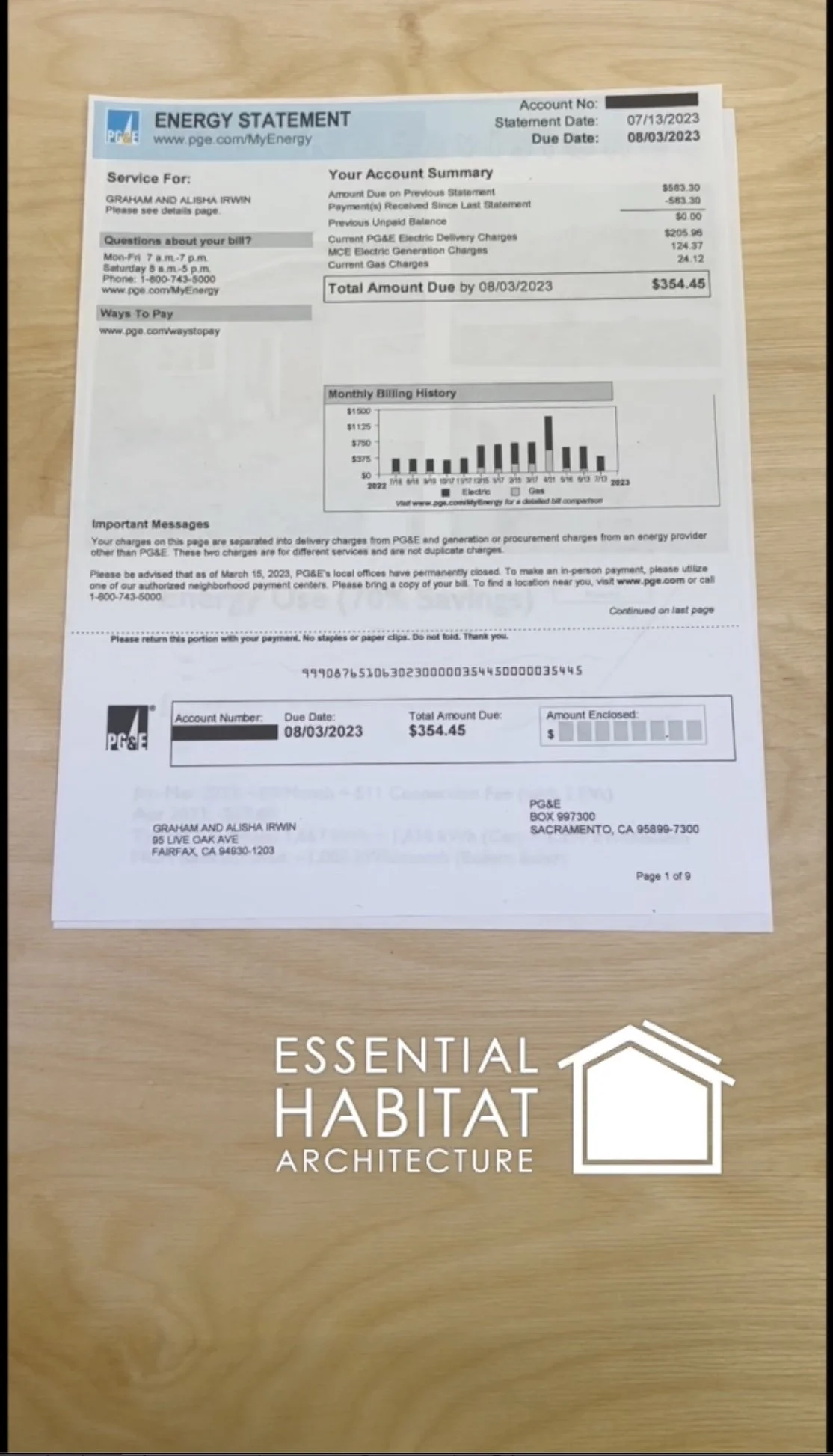High Performance vs. Net Zero?
I had an interesting conversation with a prospective client the other day, during which they said “Net-zero is a lot less specific than high-performance. If you add enough solar panels to any home, you can make it net-zero.” I agreed and added that you can also make any home net-zero with no solar panels at all – simply disconnect the energy supply!
What’s common to both scenarios (besides net-zero energy use) is that there’s no assurance of comfort, indoor air quality, quiet, resiliency, water efficiency, low environmental impact, fire-hardening, or any of the other benefits we bring to our high-performance home designs.
The foundation of a high-performance home is not low energy use; it’s outstanding livability without the need for much energy. Low or net-zero energy is the happy, and crucial, result.
It’s not that typical homes are designed to be low performing energy hogs on purpose, they’re just not intentionally designed to be high performing. Excellent performance doesn’t happen by accident – it requires expertise, experience, and commitment. What’s more, with good design, the additional investment to attain these benefits is minimal.
Does this resonate with you? Do you want to create an outstanding new home or upgrade the home you have? Schedule a conversation with me here.
The best kept secret in California real estate…
High-performance homes!
I was certified in high-performance (passive) home design in 2008, and I remember thinking at the time “this makes so much sense, it will be widespread in California in no time.” Seventeen years later, we’re not there yet. Why?
Beyond a general lack of awareness, I think there’s a perception that it’s something you choose to be virtuous about climate change (TRUE) but that it’s expensive, and without tangible benefits.
FALSE! For an additional investment of 10-15% you get a lifetime of unsurpassed comfort, outstandingly fresh indoor air (even during wildfire smoke events), serene quiet, and low or no energy bills, including car charging. A bright, resilient, fire-hardened home, seamlessly connected to the landscape. I consider that better design and higher-quality construction for better living!
Do you want to explore creating an outstanding new home, or upgrading the one you have? Schedule a conversation here.
Heat wave? What heat wave?
It’s been mercifully cool this summer in the SF Bay Area so far. Cool to cold, like “Mark Twain in San Francisco” cold. Not great for swimming, but pleasant for those of us at work!
Anyhow, my gratitude extended to sympathy for those folks elsewhere enduring heat waves, prompting a reflection on some data from one of our high-performance home projects that I still find astounding - and I designed it!
This 1922 Craftsman in Santa Cruz was redesigned and upgraded to Passive House performance. This house has no A/C, so the owners cool the house, when necessary, by opening windows at night or in the morning. As the day warms up, they close the windows and use their heat recovery ventilation for a superbly comfortable and clean indoor environment.
Anyhow, during a freak heat wave, it got up to >100ºF outside. The warmest indoor temperature was 77ºF. WITHOUT AIR CONDITIONING!
How does this help in hotter climates? Even if it’s too warm and/or humid at night for natural cooling, these homes can “store” their indoor temperature for a long time. Instead of running your cooling system at the hottest time of the day, you can choose when it’s convenient.
Maybe that’s the middle of the day when solar output is highest, or in the middle of the night when the system runs most efficiently. Regardless, you can avoid running it during peak demand, when occupants of low-performing buildings are forced to either pay high energy costs, or suffer discomfort, or both. If the grid does go out, a high-performance home is comfortable, and livable, for much longer too.
High-performance homes excel in both summer and winter. Do you want to explore creating an outstanding new home or upgrading the home you have? Schedule a consultation with us here.
Floppy Disks, Really?
Can you imagine, still relying on a 50+ year old technology?
I read this article yesterday with bemusement, as I’m sure many others did. It’s hard to believe the San Francisco transit system still runs on something as obsolete as floppy disks! Dating myself, my 1st computer, an Apple ][+, had no hard drive and the keyboard was uppercase only. I loved it, at the time!
Anyhow, it made me think how this obsolescence is viewed with shock, yet we generally accept, and still build, houses with technology that has barely advanced from the 1950s. That’s 75-ish years old, making floppy disks look new-fangled!
What do I mean by this?
1. The approach to indoor air quality is “exhaust-only.” Bath fans and range hoods that intermittently suck stale air out of the house, with no thought given to the air that replaces it – basically sucking dust, pollen, wildfire smoke, and other pollutants into the house through cracks in the walls and floor.
2. Insulation as a “ritual afterthought.” Haphazardly stuffed into whatever space is available, with gaps in some of the worst possible places and interrupted by some of the most thermally conductive materials, like metal and concrete.
3. Windows and doors that are designed, constructed, and installed with insufficient thought to what’s needed. Doors and windows that can never really “close,” severely compromise the overall comfort of the home, and which fail to shield the occupants from street noise and outdoor pollutants.
Yes, you can open the windows in a high-performance home (many of our designs have huge, amazing, operable units), but you can also “close” them when you want!
4. Building assemblies that allow air to leak inside and find its way to surfaces that cause condensation, leading to mold, mildew, and rot.
5. Design and construction that aims for mere compliance with building codes. Despite most of the effort and expense required for an “A+” home, the result is a “D” – a home prone to stale air, drafty, noisy, and only marginally comfortable despite high energy use.
By contrast, high-performance homes are designed and constructed carefully. Centralized ventilation systems continuously exhaust bathrooms and kitchens and supply filtered, fresh, comfortable air to bedrooms and other living spaces.
The insulation is intentional, and optimized. High quality windows and doors provide plentiful daylight with balanced solar gains, and foster incredible indoor-outdoor connection without compromising the shelter.
The result is a “sanctuary in the modern world” – comfortable, quiet, healthy, and clean. With no energy bills, including car charging. Resilient and safe during grid outages and wildfire smoke events. A home you’ll feel great living in and feel great about owning!
This is readily achievable now! Join the ranks of our satisfied clients – book an appointment to discuss the details.
Passive House in L.A., Why Bother? Here’s Four Reasons.
Introduction
Amidst coverage last week of the devastating Los Angeles fires came a social media post that went viral, of a “Passive House-inspired” home in Pacific Palisades that survived while its neighbors were destroyed.
Speculation ensued about which aspects of Passive House were responsible for the home’s survival. The architect was interviewed, and when asked about Passive House, concluded “We live in a benign climate here in Southern California… A lot of the measures used in Passive House become overkill.” As a long-time Passive House practitioner in California, I feel obliged to clear up some misconceptions, and share four big benefits our clients gain, even in mild climates.
While the “Nordic modern minimalism” of this home is seen in many Passive House projects, Passive House is not an architectural style. It is, rather, an approach to design and construction focused on creating high-performance buildings. Through precise energy modeling and meticulous design and construction, a Passive House/Building (it’s not just for houses) is created that is largely in balance with its environment. Inherently comfortable, it requires little in the way of “active” heating and cooling, hence the “Passive” moniker.
©2025 Essential Habitat Architecture
A “certified” project is confirmed by a third party to have been designed and constructed to meet exacting Passive House/Building “standards” regarding comfort, air quality, and energy efficiency. While the standards vary a little, the requirements are similar for all projects, so what’s required to achieve this level of performance depends on the design and location. In other words, a Passive House/Building in Minnesota requires much more insulation than one in Southern California, but they’re both equally comfortable and efficient. Calling Passive House “overkill” for Los Angeles misses the fact that this it’s based around climate and project-specific optimization.
Furthermore, it implies that the benefits offered are undesirable and/or unworthy of the effort required to achieve them. As an architect with more than fifteen years’ experience designing high-performance Passive Houses and Buildings in California, I wholeheartedly disagree. What follows are four noteworthy benefits delivered to owners and occupants, even in Los Angeles:
Benefit #1: Health
©2025 Essential Habitat Architecture
Typical buildings are very leaky. Cracks and holes in the exterior make it difficult to control the volume of air moving in and out of the building, and nearly impossible to control where this air originates. This leaves the occupants of a typical building subject to outdoor air pollution, dust, pollen, insects, and vermin. Much of the air they breathe comes from the worst possible locations – a study in Washington state found that roughly 40% of the indoor air in the test houses came from crawl spaces.
High-performance buildings, by contrast, are meticulously constructed to eliminate leaks. Indoor air quality is ensured via carefully calibrated ventilation systems that continually remove stale air from bathrooms, kitchens, and laundries. This air is replaced with fresh, filtered air from optimal outdoor locations, silently delivered throughout the living spaces. Studies and anecdotal evidence show benefits including better sleeping, reduction of allergy and asthma symptoms, and improved energy and productivity, among others. In the event of wildfire smoke events, supplemental filtration can be added, which has been shown to markedly improve indoor air quality. These buildings are not hermetically sealed - when outdoor connection is desired, doors and windows are easily opened, and natural ventilation for cooling is a strategy that’s commonly employed. We leverage large, high-quality windows and doors for dramatic effect in our projects, emphasizing indoor-outdoor connection.
Benefit #2: Comfort
The basis for great building performance is comfort. Decades of experience and research have been applied to create buildings that are in balance with their surroundings, needing little in the way of supplemental “active” heating and cooling for consistent comfort. The temperature of all the indoor surfaces (ceilings, walls, windows, and floors) is optimized, and the glazing is carefully shaded. Our clients are consistently thrilled with the comfort of their homes. Their biggest issue seems to be, when traveling, how uncomfortable other houses seem in comparison.
Image Source: Albert, Righter and Tittmann Architects
While Los Angeles has a mild climate and sleeping outdoors in winter is likely survivable, it is often far from comfortable. Many homes in the area are poorly suited for year-round comfort, requiring far more energy and equipment than necessary. With tens of thousands of Passive Houses/Buildings across North America, throughout Europe, and around the world providing vastly superior comfort without a typical furnace, it’s worth asking why there should be any building in Los Angeles that needs one.
Benefit #3: Quiet
I’ve been designing high-performance homes and buildings since 2008, yet every time I visit one, I’m still amazed at how quiet and peaceful they are inside. They are truly “sanctuaries in the modern world.”
Image Source: NK Architects
NK Architects, now NK Passive, quantified this effect by commissioning acoustic engineers to study it. They found that outside noise transmission was reduced by at least 50% from a conventional building. We have clients who enjoy the serenity of country living in the middle of San Francisco. For others, who live on a busy street in suburbia, traffic noise is a distant memory.
Benefit #4: Efficiency
In addition to a robust exterior envelope, high-performance buildings use best-in-class lighting, appliances, and equipment. The result is overall energy savings on the order of 75% when compared to typical construction. This radical level of efficiency imparts several advantages - utility costs are lowered for a lifetime, they’re easily powered with solar and can function far longer on batteries during grid outages, and the environmental impact is greatly reduced.
©2025 Essential Habitat Architecture
Clients with a 3 bedroom, 2-1/2 bath, high-performance, all-electric home had electric bills that averaged $20 a month for January through March of 2023, $11 per month of which was the connection fee. Solar output in April yielded a bill of -$67, which paid those months off. They have a typically sized 8 kW solar system and two Tesla Powerwalls which enable them to live their lives, completely uninterrupted, during power outages. This includes charging two EVs.
How Well Does It Work?
We studied the difference between Passive House and California code by taking a state-approved, single-family home prototype and upgrading it to Passive House performance in each of the state’s 16 climate zones. We found variation with climate, as expected, but even in Los Angeles’ three climate zones: CZ6 (coastal), CZ8 (inland south), and CZ9 (inland north), the energy required to heat and cool a single code house was sufficient for three or four of the upgraded houses, respectively. For the sake of clarity in the study, we restricted ourselves from any architectural improvements - this would have yielded even better results.
©2025 Essential Habitat Architecture
What Does It Take?
We’ve developed powerful optimization software, and we used it to carefully chose the most effective upgrades to the code-built house in each climate. We found that the only upgrades required for Passive House performance in Los Angeles were improved air-tightness and insulation for slab-on-grade foundations.
©2025 Essential Habitat Architecture
What Does It Cost?
The additional up-front investment required to achieve the benefits of high-performance varies with the specifics of the project, but we find that 10-15% is typical for single-family projects in California, with higher end projects seeing lower incremental costs.
What About Fire Resistance?
While many of the measures employed in the Pacific Palisades home are consistent with Passive House, they’re more specifically associated with “wildfire-hardening,” which is now required by code in high-risk, “Wildland Urban Interface” (WUI) zones throughout California. This guide, which may also help lower insurance premiums, offers more insight.
Image Source: IBHS
With an eye also cast toward high-performance, however, some aspects of wildfire-hardening can be achieved with techniques that provide multiple benefits. For example, the architect stated that the exterior walls of the Pacific Palisades house have a “one-hour fire rating.” This was probably achieved by wrapping the exterior in fire-rated gypsum board, or the equivalent. We fire-harden our projects as standard practice but, instead of gypsum board, we utilize exterior “stone wool” insulation for a one-hour fire rating that also provides significant comfort and efficiency improvements.
Conclusions
Our experience has found tangible benefits from high-performance buildings, even in mild climates like coastal California. Through concerted effort, we’ve developed ways to achieve this with a minimum of exotic materials and techniques, relying mainly on conscientious design and careful construction. In addition to improving the lives of owners and occupants, high-performance buildings are crucial to mitigating climate change, which is likely responsible, in part, for these disastrous fires. If we’re to escape the environmental damage of fossil fuels, we’ll need to shift to all-electric buildings that are optimized for renewable energy. We call what we do “Architecture for the Future of California.” It’s a double-entendre that speaks of buildings that meet the challenges we face moving forward, and which promise a bright, healthy future for the people our clients love and the places we all cherish.
If you’d like to help encourage high-performance building in California, you can sign this petition to make Passive House an official option for compliance with the state energy code.
The Nuance of Net-Zero
I recently viewed an entertaining and informative presentation by Chris Baker of Willdan, hosted by PG&E as part of their energy education classes. He advances the "heretical" view that buildings must be designed to be "grid friendly" vs. merely "net zero." As a fellow heretic, I wholeheartedly agree!
HAPPY HOLIDAYS!
California’s Solar Glut?
Interesting, and critical, article in the LA Times about the impact of solar power on California's grid. It has generated a lot of response. I'm interested in others' insights, but I'll posit the following: 1. The energy market is broken, due to the externalities of fossil fuels, and our society is so dependent on low-cost fossil fuels that correcting this directly is politically and practically impossible, hence the government intervention. 2. Forbes reports that the fossil fuel industry is directly subsidized to the tune of $757 billion/year by US taxpayers and by ~$7 trillion annually (explicit and implicit) worldwide, according to the IMF. Solar subsidies are a tiny fraction of that.
Concerned about Climate Change? Pursue Joy!
I recently learned of a study which found that people who are concerned with climate change tend to react in one of two ways – those who know more about the issue feel guilty they aren’t doing enough, and those who know less feel guilty they don’t know more. While being concerned about this crisis is understandable, reacting solely out of guilt is not the most effective approach.
First, it’s unlikely that unpleasant choices will be maintained, just as “diets” tend to fail vs. approaches to healthy eating that emphasize delight. Secondly, unpleasant choices are unlikely to inspire others to follow suite, and solving this problem requires widespread change. Fortunately, a clean energy lifestyle is now within reach, and replete with benefits.
If you’re building a new house or undertaking a major remodel, opt for a high-performance home. High-performance (passive) homes are carefully designed and constructed to be in balance with the environment, requiring minimal heating and cooling to stay comfortable. They’re also incredibly healthy, quiet, durable, and resilient during blackouts. High-quality windows and doors provide for bright interiors and sweeping, dramatic views while maintaining comfort, quiet, and security.
Outstanding energy efficiency (80% savings over typical homes is common) makes it easy to eliminate your power bills with a typical solar system, including car charging. A modest upfront additional investment (10-15%) yields dividends over the life of your home. Ultimately, you’re opting for a home that’s inherently comfortable with the beneficial byproduct of a light environmental footprint, not freezing in the dark. We see this as leading by example toward a bright, healthy future for us all. Explore our website to learn more and/or get in touch – we’re happy to discuss the possibilities!
Photo credit: Our dog, Rama, frolicking in the snow at Lake Tahoe, courtesy of my very talented wife Alisha Peterson-Irwin.
Home Performance Rap?
OK, more like “spoken word,” but it works, I think! ;-)
LOW energy costs for a high-performance home in Sunnyvale, CA
30 MPG. WTF?!
This past weekend we traveled to southern California and wound up renting a car (we’re eagerly awaiting the long-promised delivery of our own EV.) I wanted to rent an EV, because they’re better in nearly every aspect, but even leaving at 7 AM barely left us enough time to get there in time for an event, and I didn’t want to mess with charging in the middle of the Central Valley. I set aside my idealism and opted for a gas-powered vehicle.
During our drive south on I5, I looked at the dash and saw that our average gas mileage was less than 30 - in an unremarkable vehicle! I was shocked that cars which perform this poorly are still produced and sold in this day and age. We can, will, and must do much better!
Predictably, my thoughts turned to architecture. There isn’t a widely used, accurate metric like “miles per gallon” to understand the performance of our buildings, but I know that most homes, even newly designed and constructed, fall well short of what’s now readily achievable. In addition to vastly better comfort, air quality, and noise reduction, we commonly see 80%+ energy use reductions in our high-performance projects compared to standard construction, before solar. These projects are essentially the “EVs of architecture.” To quote my last paragraph, “We can, will, and must do much better!”

